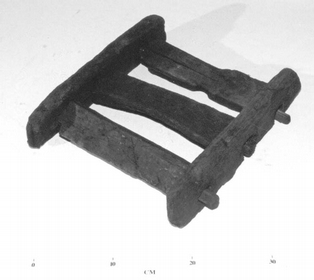English Coal Mining History at the NCMME
Wooden sledge, Ryefield, Derbyshire
© National Coal Mining Museum for England (Photo: National Coal Mining Museum for England)
© National Coal Mining Museum for England (Photo: National Coal Mining Museum for England)
Opencast mining takes place where coal seams lie close to the surface. It involves excavating large areas of ground, and this often reveals early workings at shallow depth. The Museum has many objects in its collections found in old workings exposed in this way. This wooden sledge would have been used to pull coal, probably in baskets, from seams worked underground, but close to the surface.
Small, shallow mine workings, both for ironstone and coal are found extensively in West Yorkshire. A shaft was dug and the coal dug out around the shaft base, a mine type known as Bell Pits because of their shape. These pits were only good if the coal seam was no futher than a few metres underground because if they were dug too deep, there was often the chance that the roof would fall in, or ventilation was a problem.
Miners eventually developed methods of excavating deeper levels of coal by sinking vertical shafts with tunnels leading from the main shaft. Once a method for pumping out water from the mine was developed, this method of mining was developed futher and continues to be used today.
Small, shallow mine workings, both for ironstone and coal are found extensively in West Yorkshire. A shaft was dug and the coal dug out around the shaft base, a mine type known as Bell Pits because of their shape. These pits were only good if the coal seam was no futher than a few metres underground because if they were dug too deep, there was often the chance that the roof would fall in, or ventilation was a problem.
Miners eventually developed methods of excavating deeper levels of coal by sinking vertical shafts with tunnels leading from the main shaft. Once a method for pumping out water from the mine was developed, this method of mining was developed futher and continues to be used today.


